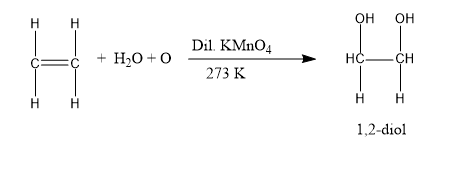
A gas formed by the action of alcoholic KOH on ethyl iodide decolourises alkaline \[{\rm{KMn}}{{\rm{O}}_{\rm{4}}}\] . The gas is:
A. \[{{\rm{C}}_{\rm{2}}}{{\rm{H}}_{\rm{6}}}\]
B. \[{\rm{C}}{{\rm{H}}_{\rm{4}}}\]
C. \[{{\rm{C}}_{\rm{2}}}{{\rm{H}}_{\rm{2}}}\]
D. \[{{\rm{C}}_{\rm{2}}}{{\rm{H}}_{\rm{4}}}\]
Answer
222k+ views
Hint: The dehydrohalogenation reaction is the reaction of an alkyl halide in which the removal of a hydrogen atom and a halogen atom takes place in presence of the action of alcoholic KOH. The obtained product in the reaction is an alkene.
Complete Step by Step Answer:
Let’s understand the dehydrohalogenation reaction of ethyl iodide by the action of potassium hydroxide which is alcoholic in nature. In this reaction, a molecule of hydrogen iodide is removed from the compound, and an alkene forms. The reaction is as follows:
\[{{\rm{C}}_{\rm{2}}}{{\rm{H}}_{\rm{5}}} - {\rm{I}} + \,{\rm{Alc}}{\rm{.}}\,{\rm{KOH}} \to {{\rm{C}}_{\rm{2}}}{{\rm{H}}_{\rm{4}}}\]
So, the formation of ethene takes place in the above reaction.
Now, we will understand the decolorization of \[{\rm{KMn}}{{\rm{O}}_{\rm{4}}}\]. We know that pink colour of potassium permanganate (\[{\rm{KMn}}{{\rm{O}}_{\rm{4}}}\]) disappears when it undergoes a reaction with unsaturated compounds (alkene and alkyne). This reaction is termed Baeyer’s reaction. And Baeyer’s reagent is cold, acidified, and dilute potassium permanganate. And in this reaction, the formation of 1,2-diol occurs. The chemical reaction is shown below:

Image: Baeyer’s test
So, the gas produced in the dehydrohalogenation reaction of ethyl iodide, that is, ethene (\[{{\rm{C}}_{\rm{2}}}{{\rm{H}}_{\rm{4}}}\]) can decolorize the potassium permanganate.
Therefore, option D is right.
Note: It is to be noted that only the acidic nature of potassium permanganate gives the test of unsaturation. If the medium is alkaline, the reaction will change. In such conditions, the purple coloured permanganate (VII) changes to green coloured manganate (VII) ions first and then changes to manganese (IV) oxide which is of dark brown colour.
Complete Step by Step Answer:
Let’s understand the dehydrohalogenation reaction of ethyl iodide by the action of potassium hydroxide which is alcoholic in nature. In this reaction, a molecule of hydrogen iodide is removed from the compound, and an alkene forms. The reaction is as follows:
\[{{\rm{C}}_{\rm{2}}}{{\rm{H}}_{\rm{5}}} - {\rm{I}} + \,{\rm{Alc}}{\rm{.}}\,{\rm{KOH}} \to {{\rm{C}}_{\rm{2}}}{{\rm{H}}_{\rm{4}}}\]
So, the formation of ethene takes place in the above reaction.
Now, we will understand the decolorization of \[{\rm{KMn}}{{\rm{O}}_{\rm{4}}}\]. We know that pink colour of potassium permanganate (\[{\rm{KMn}}{{\rm{O}}_{\rm{4}}}\]) disappears when it undergoes a reaction with unsaturated compounds (alkene and alkyne). This reaction is termed Baeyer’s reaction. And Baeyer’s reagent is cold, acidified, and dilute potassium permanganate. And in this reaction, the formation of 1,2-diol occurs. The chemical reaction is shown below:

Image: Baeyer’s test
So, the gas produced in the dehydrohalogenation reaction of ethyl iodide, that is, ethene (\[{{\rm{C}}_{\rm{2}}}{{\rm{H}}_{\rm{4}}}\]) can decolorize the potassium permanganate.
Therefore, option D is right.
Note: It is to be noted that only the acidic nature of potassium permanganate gives the test of unsaturation. If the medium is alkaline, the reaction will change. In such conditions, the purple coloured permanganate (VII) changes to green coloured manganate (VII) ions first and then changes to manganese (IV) oxide which is of dark brown colour.
Recently Updated Pages
Types of Solutions in Chemistry: Explained Simply

States of Matter Chapter For JEE Main Chemistry

Difference Between Alcohol and Phenol: Structure, Tests & Uses

Conduction Explained: Definition, Examples & Science for Students

Balancing of Redox Reactions - Important Concepts and Tips for JEE

Atomic Size - Important Concepts and Tips for JEE

Trending doubts
JEE Main 2026: Application Form Open, Exam Dates, Syllabus, Eligibility & Question Papers

Derivation of Equation of Trajectory Explained for Students

Hybridisation in Chemistry – Concept, Types & Applications

Understanding the Angle of Deviation in a Prism

How to Convert a Galvanometer into an Ammeter or Voltmeter

Degree of Dissociation: Meaning, Formula, Calculation & Uses

Other Pages
Solutions Class 12 Chemistry Chapter 1 CBSE Notes - 2025-26

NCERT Solutions For Class 12 Chemistry Chapter 1 Solutions - 2025-26

The D and F Block Elements Class 12 Chemistry Chapter 4 CBSE Notes - 2025-26

NCERT Solutions for Class 12 Chemistry Chapter Chapter 7 Alcohol Phenol and Ether

NCERT Solutions ForClass 12 Chemistry Chapter Chapter 8 Aldehydes Ketones And Carboxylic Acids

JEE Advanced Marks vs Ranks 2025: Understanding Category-wise Qualifying Marks and Previous Year Cut-offs




